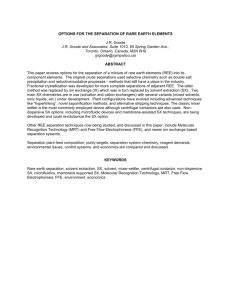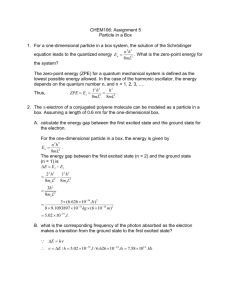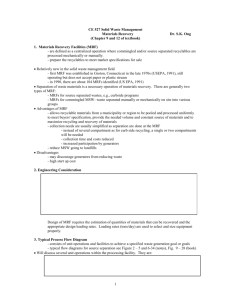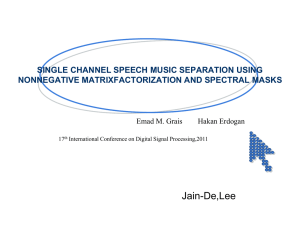powerpoint - University of Illinois at Urbana
advertisement
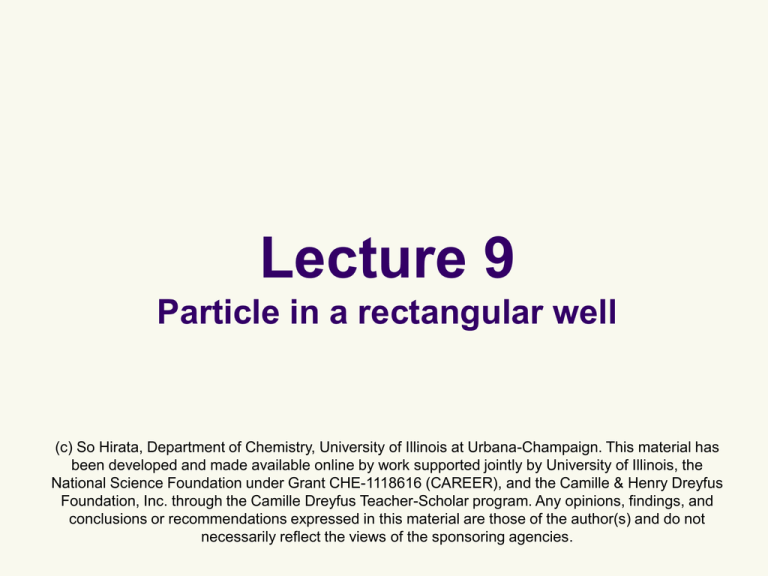
Lecture 9 Particle in a rectangular well (c) So Hirata, Department of Chemistry, University of Illinois at Urbana-Champaign. This material has been developed and made available online by work supported jointly by University of Illinois, the National Science Foundation under Grant CHE-1118616 (CAREER), and the Camille & Henry Dreyfus Foundation, Inc. through the Camille Dreyfus Teacher-Scholar program. Any opinions, findings, and conclusions or recommendations expressed in this material are those of the author(s) and do not necessarily reflect the views of the sponsoring agencies. Motion in two or more dimensions The particle in a rectangular well extends the previous 1D problem to 2D. This introduces two important concepts: Separation of variables – a very powerful and general technique in reducing the dimension of differential equations. Degenerate eigenfunctions. The particle in a rectangular well The Schrödinger equation for this is: 2 æ ¶2 ¶2 ö + 2 ÷ Y = EY 2 ç 2m è ¶x ¶y ø Boundary conditions are: ( x , y ) 0, x 0, L1 x y 0, L 2 y Separation of variables When a differential equation is two or higher dimensional such as 2 æ ¶2 ¶2 ö + 2 ÷ Y = EY 2 ç 2m è ¶x ¶y ø We must always attempt separation of variables. With this, a 2D problem breaks down into two 1D problems. This happens if the solution is the product of functions of each of the variables Ψ = X(x)Y(y) with no cross term like Z(x,y). Separation of variables To see separation of variables indeed occurs, we first assume it does and write the solution in the product form: æ ¶2 ¶2 ö + 2 ÷ Y(x, y) = EY 2 ç 2m è ¶x ¶y ø 2 æ ¶2 ¶2 ö + 2 ÷ X (x)Y ( y) = EX (x)Y ( y) 2 ç 2m è ¶x ¶y ø 2 Separation of variables The partial derivative ∂2/∂x2 will act only on the X(x) part (similarly for ∂2/∂y2 on Y), hence 2 æ ¶2 æ ¶2 X ¶2 ö ¶2Y ö + 2 ÷ X (x)Y ( y) = Y + X 2 ÷ = EXY 2 2 ç ç 2m è ¶x ¶y ø 2m è ¶x ¶y ø 2 Divide by XY the both sides. æ 1 ¶2 X 1 ¶ 2Y ö + =E 2 2÷ ç 2m è X ¶x Y ¶y ø 2 It has the form: f(x) + g(y) = e. This immediately means f(x) and g(y) are individually constant. Separation of variable indeed took place. F(x) + G(y) = constant Separation of variables æ 1 ¶2 X 1 ¶2Y ö + = E = E X + EY 2 2÷ ç 2m è X ¶x Y ¶y ø 2 1 ¶2 X = EX 2 2m X ¶x 1 ¶2Y = EY 2 2m Y ¶y ¶ X = EX X 2 2m ¶x ¶2Y = EY Y 2 2m ¶y 2 2 2 2 2 These are the particle in a box equations! Separation of variables 2 X n1 ( x ) L 1 1/ 2 sin L1 2 E n1 2 Yn2 ( y ) L 2 n1 x n1 h sin E n2 2 1 8m L ( x , y ) X n1 ( x )Y n 2 ( y ) 2 1 2 L1 L 2 n h 2 2 1 8m L 1/ 2 2 2 sin n h n2 h 2 8 m L2 2 2 8 m L2 n1 x L1 2 n 2 y L2 2 2 E n1 , n 2 E n1 E n 2 1/ 2 sin n 2 y L2 0 x L1 ; 0 y L 2 n1 = 1,2,… ;n2 = 1,2,… The particle in a three-dimensional box The argument can be easily extended to 3D: 8 ( x, y, z ) L1 L 2 L 3 1/ 2 sin n1 x sin n 2 y L1 sin n 3 z L2 L3 0 x L1 ; 0 y L 2 ; 0 z L3 2 E n1 , n 2 , n3 E n1 E n 2 E n3 n1 h 2 2 1 8m L 2 n2 h 2 2 8m L 2 2 n3 h 2 8m L We now have three quantum numbers. 2 3 Degeneracy Let us suppose L1 = L2 = L in the 2D case. Then the energy is, 2 E n1 , n 2 n1 h 2 8m L 2 2 n2 h 2 8m L ( n1 n 2 ) 2 2 2 h 2 8m L 2 This expression gives identical energy for (n51h, 2 n2) = (2,1) or (1,2). We say the energy is 2 8m L doubly degenerate in that two different eigenfunctions correspond to this eigenvalue. Degeneracy The degeneracy is often caused by high symmetry. For the square well case, (n1, n2) = (2,1) and (1,2) wave functions are related by 90° rotation around the center. These two states are distinguished by different probability densities. 90° rotation 90° rotation Degeneracy When two wave functions Ψ1 and Ψ2 are doubly degenerate: Hˆ E an d Hˆ E 1 1 2 2 Then any linear combination of Ψ1 and Ψ2 is also an eigenfunction with the same eigenvalue. Hˆ c1 1 c 2 2 E c1 1 c 2 2 We can use this property to make Ψ1 and Ψ2 orthogonal to each other. Summary We have introduced the powerful separation of variables technique for differential equations in two or higher dimensions. All two- and higher-dimensional Schrödinger equations we study in this course depends on this powerful technique. Some eigenvalues are degenerate – more than one eigenfunctions correspond to one eigenvalue.
